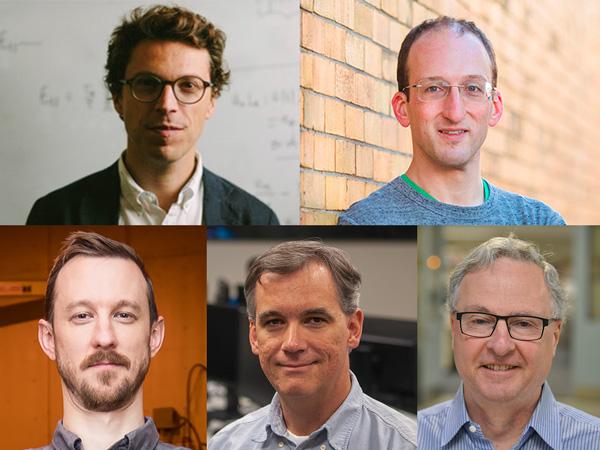
Clockwise from top left: Nuno Loureiro, Mike Short, Earl Marmar, Jerry Hughes, Zach Hartwig, MIT
Loureiro/Jared Charney; Short/Gretchen Ertl; Marmar, Hughes/Paul Rivenberg; Hartwig/Bryce Vickmark
Five from Center assume new duties to support the growth of collaborations, research, and education at MIT
May 6, 2022
In response to increased support and momentum for fusion energy and plasma science research at MIT and around the world, a new leadership team at the Plasma Science and Fusion Center (PSFC) has evolved to tackle strategic planning for the coming five years.
In a year that saw global fusion research reaching long-awaited milestones, the Center, in collaboration with MIT spinout Commonwealth Fusion Systems (CFS), successfully created a high-temperature superconducting (HTS) magnet that broke magnetic field strength records, paving the way for building SPARC, a compact, high-field, net fusion energy device. The increased visibility and interest that accompanied this research has generated new faculty and staff hires, as well as a record number of entering graduate students. Beyond its large fusion portfolio, the PSFC has established research in such areas as geo-thermal microwave drilling and HTS magnets for applications outside fusion.
As the PSFC expands its collaboration with CFS with a five-year renewal of their research partnership, Director Dennis Whyte has assembled a dynamic leadership team to strategize and support the future growth of the Center. Joining Whyte in steering the Center towards shared goals are Professor of Nuclear Science and Engineering and Physics Nuno Loureiro, Class of ’42 Associate Professor of Nuclear Science and Engineering Michael Short, Head of PSFC Magnetic Fusion Energy Division and Physics Senior Scientist Earl Marmar, Principal Research Scientist Jerry Hughes, and Robert N. Noyce Career Development Professor Zach Hartwig.
Loureiro will take on the role of Deputy Director, responsibilities previously managed by Senior Research Scientist Martin Greenwald before his recent retirement. His duties will include overseeing the PSFC research initiatives on computing and theory, and directing the Center's policies and support of the graduate student program.
Loureiro notes that computing is one of the pillars of fusion and plasma research, and that the PSFC has been one of the leading institutions in this area, most recently through the exploration of new computational paradigms such as machine learning. He believes the fusion and plasma physics community at MIT can lead the way in algorithmic and hardware innovations that will yield breakthroughs. By establishing partnerships across MIT, such as with the Schwartzman College of Computing, and with other institutions and private companies, he believes “we can position ourselves to be close to the computational cutting edge and the experts who define it.”
With regard to education, Loureiro explains, “We need to grow our graduate program to accommodate all the talented students who want to work at the PSFC, ensuring they know they can flourish here. We need to welcome undergraduates into our research groups and feed their excitement. And our high visibility as MIT’s center for fusion science and technology compels us to educate the public – paving the way for the social acceptance of fusion as an Earth-friendly energy source, and nurturing the curiosity amongst the younger generations about what we do.”
Short will take on responsibilities of an Associate Director, overseeing and coordinating PSFC spaces, research initiatives in fusion technology, and the expansion of the undergraduate and five-years master's program. One of his challenges will be strategizing the use of space given the large influx of new students, who will all need offices and materials.
Generating more opportunities for undergraduates to explore the potential of plasma science is a goal close to his heart.
“Creating the best fusioneers starts in the first year of undergraduate education, and before,” he says. “I'll be working with various offices around MIT – UROP, SuperUROP, MITEI, Office of the First Year – to greatly increase the number of undergraduate students with substantive experiences with members of the PSFC.”
Current Associate Director Marmar will continue in this position, overseeing magnetic fusion energy (MFE) experiments. To these responsibilities he will add involvement with government relations, and oversight of the PSFC library.
Hughes, currently deputy head of MFE Off-Campus Collaborations, will become Deputy MFE Division Head, managing integrated MFE science and experimental collaborations, including SPARC. “This is an exciting time for magnetic fusion science” says Hughes. “I look forward to working with our world class scientific team to bring the experience on existing facilities to bear, and enhancing the success of SPARC.”
Hartwig will now head the PSFC Engineering Group, newly created to provide planning and execution clarity on engineering, design and tech work. While primarily composed of researchers, engineers and technician previously with the PSFC’s MFE division, the group will support all Center divisions and projects.
“In short, the objective of this initiative is to optimize the midscale engineering capabilities that make the PSFC unique amongst its peers and capable of punching above its weight to the rapidly evolving landscape of fusion energy research at PSFC,” says Hartwig. “It's a dynamic, exciting, and opportunity-rich time at PSFC with new research projects, new funding sources, new PIs, many new students, and a diversity of groups across the PSFC requesting professional engineering and technician capabilities for their experimental projects. The reorganization is about capturing this opportunity and best serving the faculty, staff, and students in their research pursuits.”
Director Whyte is enthusiastic about the new team.
“I could not be more thrilled to see this dynamic group of younger leaders commit to the development of fusion energy, and the support of a broadening education and research portfolio at the PSFC including adjacent technologies and clean energy.”
Topics: Magnetic fusion energy, Dennis Whyte, Martin Greenwald, Earl Marmar